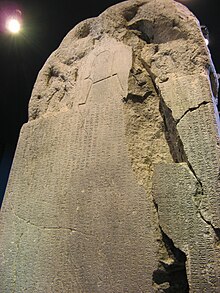
Back اللغة التركية القديمة Arabic Qədim türk dili Azerbaijani اسکی تورکجه AZB Старотюркски език Bulgarian زمانی تورکیی کۆن CKB Köktürk tili CRH Staroturečtina Czech Alttürkische Sprache German Malnova tjurka lingvaro Esperanto زبان ترکی باستان Persian
This article should specify the language of its non-English content, using {{lang}}, {{transliteration}} for transliterated languages, and {{IPA}} for phonetic transcriptions, with an appropriate ISO 639 code. Wikipedia's multilingual support templates may also be used - notably otk for Old Turkish. (January 2025) |
| Old Turkic | |
|---|---|
| East Old Turkic, Old Siberian Turkic | |
 Talas Inscription 1 | |
| Native to | Second Turkic Khaganate, Uyghur Khaganate |
| Region | East Asia, Central Asia and parts of Eastern Europe |
| Era | 8th–13th centuries |
Turkic
| |
| Dialects |
|
| Old Turkic script, Old Uyghur alphabet | |
| Language codes | |
| ISO 639-3 | otk – Old Turkish |
otk Old Turkish | |
| Glottolog | oldu1238 |

Old Siberian Turkic, generally known as East Old Turkic and often shortened to Old Turkic, was a Siberian Turkic language spoken around East Turkistan and Mongolia.[1] It was first discovered in inscriptions originating from the Second Turkic Khaganate, and later the Uyghur Khaganate, making it the earliest attested Common Turkic language. In terms of the datability of extant written sources, the period of Old Turkic can be dated from slightly before 720 AD to the Mongol invasions of the 13th century.
- ^ Rachewiltz, Igor de; Rybatzki, Volker (31 May 2010). Introduction to Altaic Philology. BRILL. p. 17. ISBN 9789004188891.